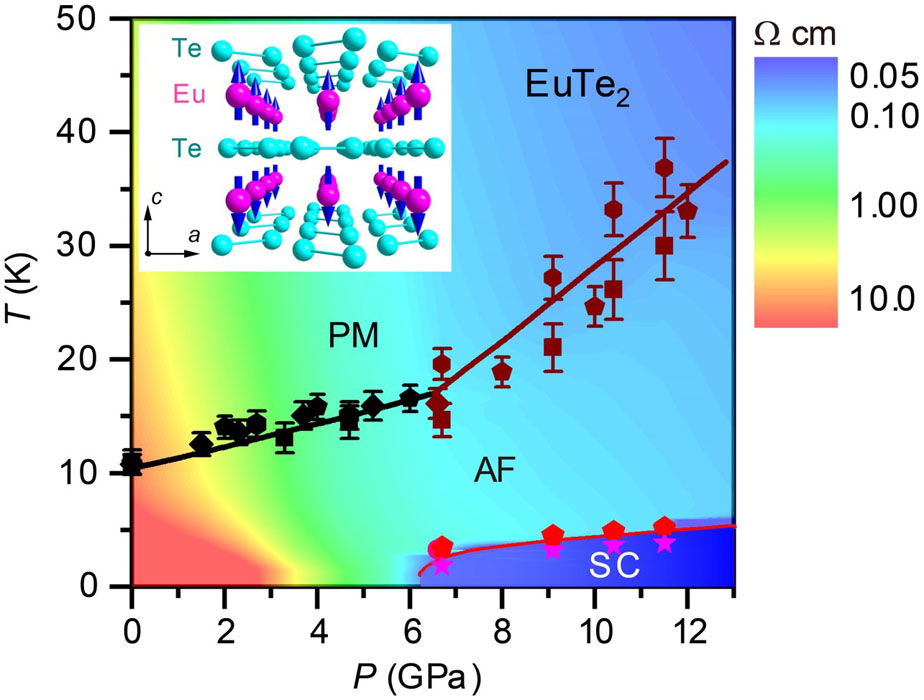Pressured-Induced Superconducting Phase with Large Upper Critical Field and Concomitant Enhancement of Antiferromagnetic Transition in EuTe2
Uwatoko Group
The interplay between static magnetism and conduction electrons has been a core topic in modern condensed matter physics spanning a broad spectrum of interesting phenomena including the Kondo physics and heavy fermions, dilute magnetic semiconductors, giant/colossal magnetoresistance, and spintronics. Recently, the addition of nontrivial band topology to this topic leads to more exotic topological quantum phenomena such as quantum anomalous Hall effect and the intrinsic large anomalous Hall effect. When the conduction electrons condense into Cooper pairs and coexist with static magnetism in the magnetic superconductors, unconventional pairing states with intriguing superconducting properties can emerge as exemplified by the U- and Eu-based magnetic superconductors. Due to the antagonistic nature between magnetism and superconductivity, however, the magnetic superconductors are rare, and the concurrence of abovementioned phenomena in a single material is even scarce. Recently, we reported on a rare case that manifests an intimated interplay among static magnetism, conduction electrons, and possible exotic superconductivity through pressure regulations on an antiferromagnetic (AF) semiconductor EuTe2 [1].
At ambient pressure (AP), EuTe2 crystallizes in a CuAl2-type tetragonal structure with space group I4/mcm. As seen in the inset of Fig. 1, each Eu2+ ion is surrounded by eight Te atoms, which form the [Te2]2− dimers stacking along the c-axis. Upon cooling down at zero field, EuTe2 exhibits a semiconducting behavior in resistivity and the Eu2+ moments develop a type-A AF order below TN = 11 K, having the c-axis-oriented ferromagnetic (FM) Eu2+ layers coupled antiferromagnetically. When an external magnetic field is applied along c-axis, the type-A AF order can be tuned into a canted AF state through a spin-flop transition at μ0H1 = 2.3 T and then a fully spin-polarized state at μ0H2 = 7.6 T. Interestingly, these field-induced transitions have a profound impact on the transport properties of EuTe2; i.e., ρ(T) under μ0H > μ0H1 is altered from semiconducting to metallic-like behavior below a characteristic temperature Tm >> TN, resulting in a large negative MR with over five orders of drop in resistivity at low temperatures. According to the density-functional-theory calculations, the charge carriers near the Fermi level originate mainly from the Te-5p orbitals and the small energy gap of Ea ≈ 16 meV at zero field can be closed by lifting the band degeneracy of the Te-5p orbitals in the spin-flop state with a net FM component. This explains the field-induced metallic state and thus the large negative MR below Tm. These results thus demonstrated an intimated interplay between the static magnetism of Eu2+ sublattice and the charge carries from Te-5p orbitals in EuTe2.
Considering the fact that many Te-containing materials become superconducting at ambient and/or high pressures, we are motived to pursue whether EuTe2 can be driven into a magnetic superconductor upon compression. So, we investigate the effect of pressure on the transport and magnetic properties of EuTe2 single crystals by using a cubic anvil cell apparatus. The main results are summarized in the temperature–pressure phase diagram of EuTe2 in Fig. 1. We find that the application of high-pressure drives EuTe2 from an AF semiconductor showing a large negative MR into a magnetic superconductor with a large upper critical field comparable to the Pauli paramagnetic limit. Interestingly, the emergence of superconductivity above the critical pressure of Pc ≈ 6 GPa is accompanied with a concomitant enhancement of TN, which experiences a quicker rise with the slope increased dramatically from dTN/dP = 0.85(14) K/GPa for P ≤ Pc to 3.7(2) K/GPa for P ≥ Pc. Moreover, the superconductivity can survive in the spin-flop state with a net FM component of the Eu2+ sublattice under moderate fields μ0H ≥ 2 T, implying a possible exotic pairing state. Our findings establish the pressurized EuTe2 as a rare magnetic superconductor, and these new results under high pressures have enriched the physics pertinent to the interplay between static magnetism and conduction electrons in this interesting compound.
References
- [1] P. T. Yang, Z. Y. Liu, K. Y. Chen, X. L. Liu, X. Zhang, Z. H. Yu, H. Zhang, J. P. Sun, Y. Uwatoko, X. L. Dong, K. Jiang, J. P. Hu, Y. F. Guo, B. S. Wang, and J.-G. Cheng, Nature Commun. 13, 2975 (2022)

